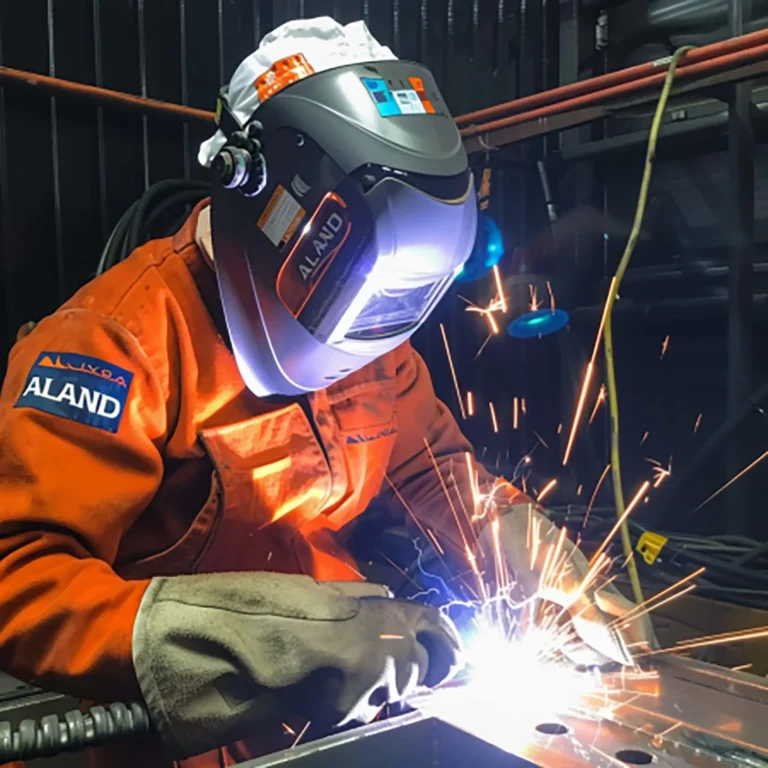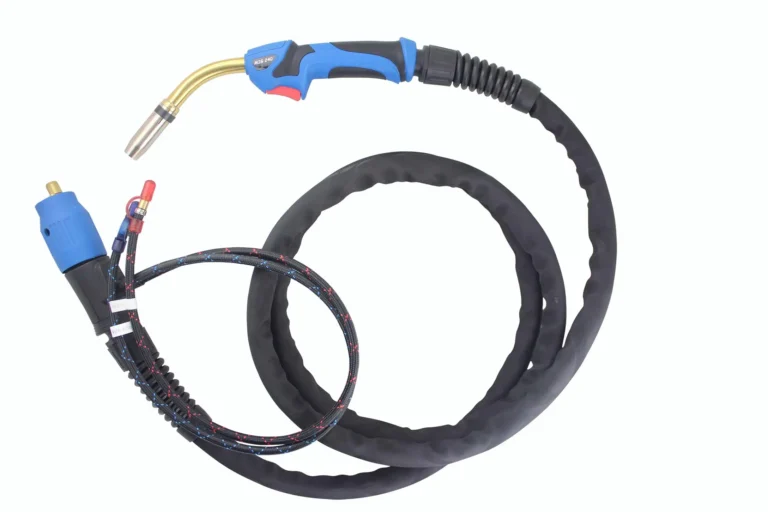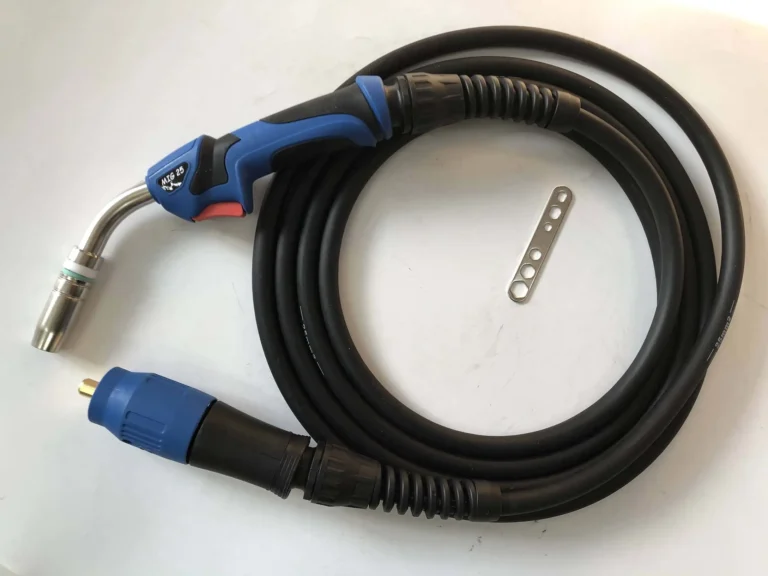arc welding gun detailed introduction

ALAND WELDING Let you feel the most sincere welding service

1. Introduction to arc welding gun
The arc welding gun refers to the part that performs the welding operation during the welding process. It is a tool used for gas welding. It is shaped like a gun and has a nozzle at the front end that emits a high-temperature flame as a heat source. It is flexible to use, convenient and quick, and has simple process.
The arc welding gun is the core tool in welding equipment. It is used to guide the arc and transport filler materials to the welding area. It mainly consists of a welding gun head, a handle, a cable assembly, a cooling system and a wire feeding mechanism. Common welding gun types include MIG/MAG welding guns (for metal inert gas and metal active gas shielded welding), TIG welding guns (for tungsten inert gas shielded welding), plasma welding guns (for high-precision and high-speed welding), and oxygen Acetylene torch (for metal cutting and special welding tasks). Welding guns are widely used in automobile manufacturing, shipbuilding, aerospace, pipeline welding and other fields. Choosing the appropriate welding gun type and configuration is crucial to improving welding quality and efficiency.
2. Classification of arc welding gun
According to different wire feeding methods, welding guns can be divided into two types: wire drawing welding guns and push wire welding guns.
Drawing type welding gun
The main features of the wire drawing arc welding gun are uniform and stable wire feeding speed and large range of movement. However, since the wire feeding mechanism and welding wire are installed on the welding gun, the structure of the welding gun is relatively complex and bulky, and can only be used for fine welding with a diameter of 0.5 to 0.8 mm. welding.
Push wire welding gun
This kind of welding gun has a simple structure and flexible operation, but the welding wire is subject to large friction resistance when passing through the hose, so only welding wires with a diameter of 1mm or more can be used for welding. Push wire welding guns can be divided into gooseneck welding guns and pistol welding guns according to their different shapes.
(1) Gooseneck arc welding gun
The structure of the gooseneck arc welding gun is shown in Figure 1. This kind of welding gun is shaped like a gooseneck and is widely used. It is very convenient when used in the flat welding position.
A typical gooseneck arc welding gun mainly includes nozzles, wire nozzles, diverters, conduit cables and other components.
①Nozzle. The shape and diameter of its inner hole will directly affect the protective effect of the gas. The gas ejected from the nozzle is required to be a pointed cone with a small top and a large bottom, covering the surface of the molten pool evenly. The diameter of the inner hole of the nozzle is 16 to 22 mm, and should not be less than 12 mm. In order to save protective gas and facilitate observation of the molten pool, the diameter of the nozzle should not be too large. Pure (purple) copper or ceramic materials are commonly used to make nozzles. In order to reduce the roughness value of its internal and external surfaces, it is required to plate a layer of chromium on the surface of the pure copper nozzle to increase its surface hardness and reduce the roughness value. The nozzle is preferably cylindrical, but it can also be made into a conical shape with a large top and a small bottom. Before welding, it is best to spray a layer of anti-spatter spray or brush a layer of silicone oil on the inner and outer surfaces of the nozzle to facilitate the removal of spatter adhering to the nozzle and extend the service life of the nozzle.
②Welding wire nozzle. Also called a conductive tip, it is commonly made of pure copper and chromium bronze. In order to ensure good electrical conductivity, reduce wire feeding resistance and ensure centering, the inner hole diameter of the wire nozzle must be selected according to the diameter of the welding wire. If the hole diameter is too small, the wire feeding resistance will be large. If the aperture is too large, the end of the delivered welding wire will swing too much, causing the weld to be uneven and poorly protected. Usually the hole diameter of the wire nozzle is about 0.2 mm larger than the diameter of the wire.
③Shunt. The diverter is made of insulating ceramics and has evenly distributed small holes. After the protective gas sprayed from the gun body passes through the diverter, it is evenly sprayed out from the nozzle in a laminar flow shape, which can improve the protection effect.
④Conduit cable. The outside of the conduit cable is a rubber insulated tube, and inside there are spring hoses, pure copper conductive cables, protective air pipes and control wires. The commonly used standard length is 3 m. If required, a 6 m long conduit cable can be used. The conduit cable is made of It consists of spring hose, inner insulating sleeve and control wire.
(2) Pistol arc welding gun
The structure of the pistol welding gun is shown in Figure 2. This welding gun is shaped like a pistol and is more convenient for welding seams in spaces other than horizontal planes. When the welding current is small, the arc welding gun uses natural cooling. When the welding current is large, a water-cooled welding gun is used.
The cooling water system of the water-cooled welding gun consists of a water tank, a water pump, a cooling water pipe and a water pressure switch: the cooling water in the water tank flows through the cooling water pipe through the water pump, flows into the welding gun after passing through the water pressure switch, and then flows back to the water tank through the cooling water pipe to form cooling water cycle. The function of the water pressure switch is to ensure that the cooling water can only start welding normally when it flows through the welding gun, and is used to protect the arc welding gun.


3.Arc welding gun work
(1) Working principle
The welding gun uses the high current and high voltage of the welding machine to gather the heat generated by the welding gun terminal, melt the welding wire, and the melted welding wire penetrates into the parts to be welded. After cooling, the welded objects are firmly connected into one. The power of the welding gun depends on the power of the welding machine and the welding material. The welding gun has qualified welding effect, safe welding, fast speed, reliable performance of the welding gun, simple maintenance and convenient adjustment. The welding gun does not use electricity, saves steel, and has small equipment investment. Welding gun gas pressure welding can easily complete the welding work of flash welding and electroslag welding equipment, and the quality and efficiency are superior to the latter two equipments.
(2) Work precautions
①After the welding gun is plugged in, never touch the tip of the gun. If you accidentally touch it, you will definitely get burned and blister, so you need to flush it with water as soon as possible;
② The welding gun head will have debris after being used for a long time, so you need to use a wiping cloth to clean it and keep it clean.
③When placing the welding gun on the welding gun holder, you still need to be careful not to touch objects next to the holder;
④After using the welding gun, you need to unplug it and wait for 10 minutes to cool down before putting it away.

4. Arc welding gun inclination angle
The angle between the axis of the welding gun and the axis of the welding seam during the welding process is called the inclination angle of the welding gun, referred to as the inclination angle of the welding gun. The inclination angle of the welding gun is a factor that cannot be ignored. When the inclination angle of the welding gun is between 80° and 110°, whether it is tilted forward or backward, it has no obvious impact on the welding process and weld formation. However, when the inclination angle is too large (such as forward inclination angle > 115°), the melting width will increase, the melting depth will decrease, and spatter will also increase.
When the welding gun and the weldment are tilted back (the arc always points to the welded part), the weld is narrow, the residual height is large, the penetration is large, and the weld is poorly formed; when the welding gun and the weldment are tilted forward (the arc is always pointed to the part to be welded) Welding part), the weld is wide, the residual height is small, the penetration is shallow, and the weld is well formed.
5. How to choose a arc welding gun
Choosing the right welding gun requires consideration of a variety of factors, including the welding process, welding materials, welding current, work environment and operator skill level. Here are some specific guidelines:
(1) Select according to the welding process
MIG/MAG welding gun:
MIG welding: suitable for aluminum, stainless steel and other materials, using inert gas such as argon for protection.
MAG welding: suitable for carbon steel and low alloy steel, using active gas such as carbon dioxide for protection.
TIG welding gun:
Suitable for welding that requires high quality welds and fine control, such as stainless steel, aluminum and their alloys. Use an infusible tungsten electrode and an inert gas (usually argon) shield.
Plasma welding gun:
It is suitable for tasks requiring high-precision and high-speed welding, and is often used in high-demand fields such as aerospace and nuclear industry.
Oxyacetylene welding gun:
Suitable for metal cutting, brazing and some special welding tasks, using high-temperature flames generated by oxygen and acetylene gas combustion.
(2) Select according to welding materials
Aluminum and aluminum alloys: Using MIG welding gun or TIG welding gun usually requires inert gas (such as argon) protection.
Stainless steel: Using a TIG welding gun or MIG welding gun requires precise control of the welding temperature and shielding gas.
Carbon Steel and Low Alloy Steel: Using a MAG welding gun, the shielding gas is usually carbon dioxide or a mixed gas.
(3) Select according to welding current
Low current welding: usually choose a welding gun with an air-cooled system, suitable for intermittent or light welding tasks.
High current welding: You need to choose a welding gun with a water cooling system to effectively dissipate heat, suitable for long-term or heavy-duty welding tasks.
(4) Choose according to the working environment
Indoor welding: Most welding guns will work, but pay attention to ventilation and fume extraction systems.
Outdoor welding: Environmental factors such as wind speed and humidity need to be considered. MIG welding and MAG welding have high requirements for shielding gas, and additional measures may need to be taken to prevent the gas from being blown away.
(5) Select according to the skill level of the operator
Beginners: It is recommended to use MIG welding gun. The operation is relatively simple and suitable for beginners to learn and use.
Professional welders: You can choose between a TIG welding gun or a plasma welding gun, which require greater operating skills but provide higher quality welds.
(6) Other factors
Welding gun weight and comfort: Long-term use requires consideration of the welding gun’s weight and handle design to reduce operating fatigue.
Welding gun maintenance and spare parts supply: Choose a welding gun brand and model that is easy to maintain and has readily available spare parts to reduce downtime and maintenance costs.

